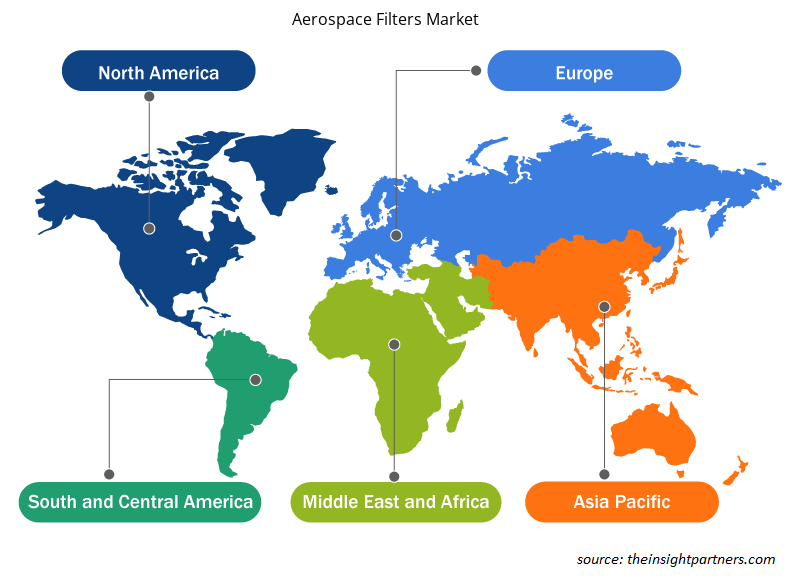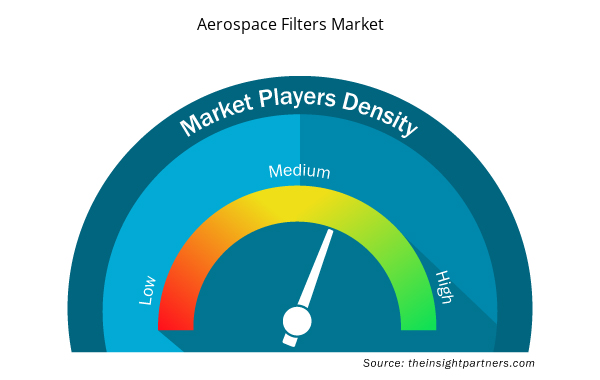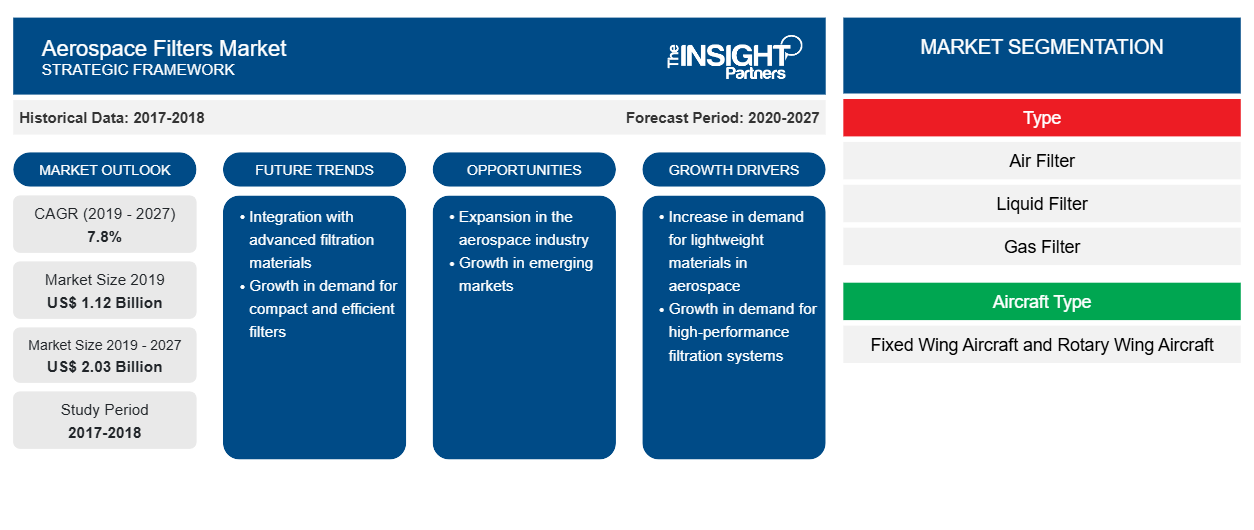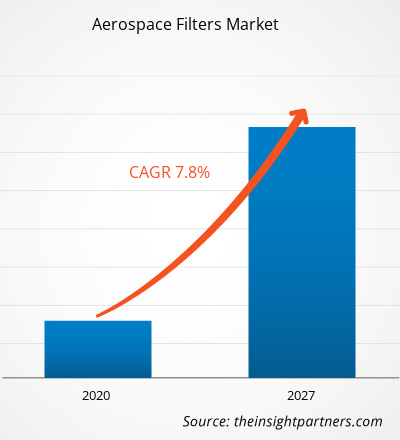2019 年航空航天过滤器市场价值为 11.171 亿美元,预计到 2027 年将达到 20.349 亿美元。预计在 2020 年至 2027 年的预测期内,航空航天过滤器市场将以 7.8% 的复合年增长率增长。CAGR of 7.8% during the forecast period of 2020 to 2027.
增加对飞机质量提升的投资,为航空过滤器市场的市场参与者提供新的机会。航空过滤产品包括各种标准过滤器组件,这些组件需要满足某些行业标准。飞机的现代化程度不断提高,加上飞机机队的增加,支持了预测期内全球航空过滤器市场的增长。污染物包括引起气味的化合物、过敏原、挥发性有机化合物和其他颗粒物,可能从系统外部进入。因此,安装了空气净化系统来处理再循环空气和外部空气(引气)。由于乘客人数众多,飞机客舱中可能存在高浓度的灰尘、细菌、纤维和其他微生物。这对乘客和机组人员的健康构成潜在危害。为了避免这种情况,在飞机内安装了用于过滤有害污染物的高效过滤器。
全球航空过滤器市场根据类型、应用、飞机类型和最终用户进行细分。根据类型,航空过滤器市场分为空气过滤器、液体过滤器和气体过滤器。根据应用,航空过滤器市场分为液压系统、发动机、航空电子设备和机舱。此外,航空过滤器市场根据飞机类型细分为固定翼飞机和旋翼飞机。根据最终用户,航空过滤器市场分为商用飞机和军用飞机。
定制此报告以满足您的需求
您可以免费定制任何报告,包括本报告的部分内容、国家级分析、Excel 数据包,以及为初创企业和大学提供优惠和折扣
- 获取此报告的关键市场趋势。这个免费样品将包括数据分析,从市场趋势到估计和预测。
航空过滤器市场洞察
频繁更换的需求不断增加
由于滤清器的使用寿命有限,预计全球航空滤清器市场在售后市场将出现巨大的增长机会。建议大约 1 至 3 年更换一次机油滤清器。如果不更换,污染物可能会进入飞机部件并造成严重损坏。飞机的有效过滤至关重要,以确保所有系统均不受污染物影响,并在具有挑战性的情况下确保可靠性、安全性、耐用性和成本效益。危险废物、温室效应和废弃废物场是环境僵局的指标。为此,许多监管机构建议积极遵守监管要求。例如,国际民用航空组织和环境保护署 (EPA) 正在制定法规,以减少商用飞机的碳排放。
基于类型的市场洞察
全球航空过滤器市场根据过滤器类型分为空气过滤器、液体过滤器和气体过滤器。空气过滤器部分在航空过滤器市场中占据主导地位,2019 年的市场份额为 50%-60%。这些飞机过滤器一直受到整个生态系统的巨大需求,即飞机制造商、飞机发动机制造商以及维护、维修和大修公司。飞机订单和交付数量的增加迫使飞机零部件制造商扩大生产线,从而提高采用率,从而在当前情况下提振航空过滤器市场。
基于应用的市场洞察
全球航空过滤器市场根据不同的应用进行分类,例如液压系统、发动机、航空电子设备和机舱等。这些领域的空气和液体过滤对于飞机的平稳运行至关重要。预测期内,机舱部分将引领市场。在机舱等封闭环境中,保持循环空气的纯度非常重要。机舱空气过滤是飞机制造商和飞机运营商的关键任务之一。维护良好的 HEPA 空气过滤系统可提高整个飞行过程中乘客和机组人员的舒适度。
基于最终用户的市场洞察
全球航空过滤器市场根据最终用户分为商用和军用。由于商用飞机交付数量显著增长,主要是固定翼飞机,飞机过滤器的采购量也在增长。空中客车、波音、庞巴迪和巴西航空工业公司等主要飞机制造商每年的飞机订单数量显著增加,这迫使他们获得大量飞机过滤器,从而增加了市场收入。
基于飞机类型的市场洞察
全球航空过滤器市场根据飞机类型分为固定翼飞机和旋翼飞机。自过去十年以来,全球航空业在数量和收入方面都经历了巨大的增长。这导致飞机数量大幅增加。在目前的航空业中,固定翼飞机的数量远远高于旋翼飞机。预计未来几年固定翼飞机的采购趋势将呈指数级增长,这为全球航空过滤器开发商带来了潜在机会。
航空航天过滤器市场的参与者专注于市场计划、收购和产品发布等策略,以保持其在航空航天过滤器市场的地位。航空航天过滤器市场主要参与者的一些发展如下:
2019 年 3 月,唐纳森航空航天与国防公司计划为 Bell 525 Relentless 交付先进的过滤系统。它是一种机油过滤器,可保护飞机的发动机、变速箱和辅助动力装置免受灰尘、污垢、沙子、盐和异物的破坏性影响。
2019 年 1 月,GKN Fokker 在荷兰首架 F-35 下线仪式上,与普惠公司达成协议,为 F135 发动机生产先进复合材料部件。制造将在位于荷兰霍赫芬的 GKN Fokker 工厂进行。
航空过滤器市场区域洞察
Insight Partners 的分析师已详细解释了预测期内影响航空过滤器市场的区域趋势和因素。本节还讨论了北美、欧洲、亚太地区、中东和非洲以及南美和中美洲的航空过滤器市场细分和地理位置。

- 获取航空过滤器市场的区域特定数据
航空过滤器市场报告范围
| 报告属性 | 细节 |
|---|---|
| 2019 年市场规模 | 11.2亿美元 |
| 2027 年市场规模 | 20.3亿美元 |
| 全球复合年增长率(2019 - 2027) | 7.8% |
| 史料 | 2017-2018 |
| 预测期 | 2020-2027 |
| 涵盖的领域 | 按类型
|
| 覆盖地区和国家 | 北美
|
| 市场领导者和主要公司简介 |
|
航空航天过滤器市场参与者密度:了解其对业务动态的影响
航空过滤器市场正在快速增长,这得益于最终用户需求的不断增长,而这些需求又源于消费者偏好的不断变化、技术进步以及对产品优势的认识不断提高等因素。随着需求的增加,企业正在扩大其产品范围,进行创新以满足消费者的需求,并利用新兴趋势,从而进一步推动市场增长。
市场参与者密度是指在特定市场或行业内运营的企业或公司的分布情况。它表明在给定市场空间中,相对于其规模或总市场价值,有多少竞争对手(市场参与者)存在。
在航空过滤器市场运营的主要公司有:
- 唐纳森公司
- 伊顿过滤有限公司
- 科德宝集团
- GKN航空服务有限公司
- 霍林斯沃思和沃斯
免责声明:上面列出的公司没有按照任何特定顺序排列。

- 获取航空过滤器市场顶级关键参与者概述
航空航天过滤器市场 – 按类型
- 空气过滤器
- 液体过滤器
- 气体过滤器
航空航天过滤器市场 – 按应用分类
- 液压系统
- 引擎
- 航空电子设备
- 舱
航空过滤器市场 – 按飞机类型划分
- 固定翼飞机
- 旋翼飞机
航空航天过滤器市场 – 按最终用户划分
- 商业的
- 军队
航空航天过滤器市场 – 按地区划分
- 北美
- 我们
- 加拿大
- 墨西哥
- 欧洲
- 法国
- 意大利
- 德国
- 英国
- 俄罗斯
- 欧洲其他地区
- 亚太地区 (APAC)
- 中国
- 印度
- 韩国
- 日本
- 澳大利亚
- 亚太地区其他地区
- 中东及非洲
- 沙特阿拉伯
- 阿联酋
- 南非
- MEA 其他地区
- 山姆
- 巴西
- 阿根廷
- SAM 其余部分
航空过滤器市场 – 公司简介
- 唐纳森公司
- 伊顿
- 科德宝集团
- GKN航空服务有限公司
- 霍林斯沃思和沃斯
- 派克汉尼汾公司
- 颇尔公司
- 波维尔旅馆
- Recco 产品
- 赛峰过滤系统
- 历史分析(2 年)、基准年、预测(7 年)及复合年增长率
- PEST 和 SWOT 分析
- 市场规模价值/数量 - 全球、区域、国家
- 行业和竞争格局
- Excel 数据集



Report Coverage
Revenue forecast, Company Analysis, Industry landscape, Growth factors, and Trends

Segment Covered
This text is related
to segments covered.

Regional Scope
North America, Europe, Asia Pacific, Middle East & Africa, South & Central America

Country Scope
This text is related
to country scope.
Trends and growth analysis reports related to Aerospace and Defense : READ MORE..
The List of Companies
- Donaldson Company, Inc.
- Eaton Filtration, LLC
- Freudenberg SE
- GKN Aerospace Services Limited
- Hollingsworth & Vose
- Parker Hannifin Corporation
- Pall Corporation
- Porvair plc
- Recco Products, Inc.
- Safran Filtration Systems
The Insight Partners performs research in 4 major stages: Data Collection & Secondary Research, Primary Research, Data Analysis and Data Triangulation & Final Review.
- Data Collection and Secondary Research:
As a market research and consulting firm operating from a decade, we have published and advised several client across the globe. First step for any study will start with an assessment of currently available data and insights from existing reports. Further, historical and current market information is collected from Investor Presentations, Annual Reports, SEC Filings, etc., and other information related to company’s performance and market positioning are gathered from Paid Databases (Factiva, Hoovers, and Reuters) and various other publications available in public domain.
Several associations trade associates, technical forums, institutes, societies and organization are accessed to gain technical as well as market related insights through their publications such as research papers, blogs and press releases related to the studies are referred to get cues about the market. Further, white papers, journals, magazines, and other news articles published in last 3 years are scrutinized and analyzed to understand the current market trends.
- Primary Research:
The primarily interview analysis comprise of data obtained from industry participants interview and answers to survey questions gathered by in-house primary team.
For primary research, interviews are conducted with industry experts/CEOs/Marketing Managers/VPs/Subject Matter Experts from both demand and supply side to get a 360-degree view of the market. The primary team conducts several interviews based on the complexity of the markets to understand the various market trends and dynamics which makes research more credible and precise.
A typical research interview fulfils the following functions:
- Provides first-hand information on the market size, market trends, growth trends, competitive landscape, and outlook
- Validates and strengthens in-house secondary research findings
- Develops the analysis team’s expertise and market understanding
Primary research involves email interactions and telephone interviews for each market, category, segment, and sub-segment across geographies. The participants who typically take part in such a process include, but are not limited to:
- Industry participants: VPs, business development managers, market intelligence managers and national sales managers
- Outside experts: Valuation experts, research analysts and key opinion leaders specializing in the electronics and semiconductor industry.
Below is the breakup of our primary respondents by company, designation, and region:

Once we receive the confirmation from primary research sources or primary respondents, we finalize the base year market estimation and forecast the data as per the macroeconomic and microeconomic factors assessed during data collection.
- Data Analysis:
Once data is validated through both secondary as well as primary respondents, we finalize the market estimations by hypothesis formulation and factor analysis at regional and country level.
- Macro-Economic Factor Analysis:
We analyse macroeconomic indicators such the gross domestic product (GDP), increase in the demand for goods and services across industries, technological advancement, regional economic growth, governmental policies, the influence of COVID-19, PEST analysis, and other aspects. This analysis aids in setting benchmarks for various nations/regions and approximating market splits. Additionally, the general trend of the aforementioned components aid in determining the market's development possibilities.
- Country Level Data:
Various factors that are especially aligned to the country are taken into account to determine the market size for a certain area and country, including the presence of vendors, such as headquarters and offices, the country's GDP, demand patterns, and industry growth. To comprehend the market dynamics for the nation, a number of growth variables, inhibitors, application areas, and current market trends are researched. The aforementioned elements aid in determining the country's overall market's growth potential.
- Company Profile:
The “Table of Contents” is formulated by listing and analyzing more than 25 - 30 companies operating in the market ecosystem across geographies. However, we profile only 10 companies as a standard practice in our syndicate reports. These 10 companies comprise leading, emerging, and regional players. Nonetheless, our analysis is not restricted to the 10 listed companies, we also analyze other companies present in the market to develop a holistic view and understand the prevailing trends. The “Company Profiles” section in the report covers key facts, business description, products & services, financial information, SWOT analysis, and key developments. The financial information presented is extracted from the annual reports and official documents of the publicly listed companies. Upon collecting the information for the sections of respective companies, we verify them via various primary sources and then compile the data in respective company profiles. The company level information helps us in deriving the base number as well as in forecasting the market size.
- Developing Base Number:
Aggregation of sales statistics (2020-2022) and macro-economic factor, and other secondary and primary research insights are utilized to arrive at base number and related market shares for 2022. The data gaps are identified in this step and relevant market data is analyzed, collected from paid primary interviews or databases. On finalizing the base year market size, forecasts are developed on the basis of macro-economic, industry and market growth factors and company level analysis.
- Data Triangulation and Final Review:
The market findings and base year market size calculations are validated from supply as well as demand side. Demand side validations are based on macro-economic factor analysis and benchmarks for respective regions and countries. In case of supply side validations, revenues of major companies are estimated (in case not available) based on industry benchmark, approximate number of employees, product portfolio, and primary interviews revenues are gathered. Further revenue from target product/service segment is assessed to avoid overshooting of market statistics. In case of heavy deviations between supply and demand side values, all thes steps are repeated to achieve synchronization.
We follow an iterative model, wherein we share our research findings with Subject Matter Experts (SME’s) and Key Opinion Leaders (KOLs) until consensus view of the market is not formulated – this model negates any drastic deviation in the opinions of experts. Only validated and universally acceptable research findings are quoted in our reports.
We have important check points that we use to validate our research findings – which we call – data triangulation, where we validate the information, we generate from secondary sources with primary interviews and then we re-validate with our internal data bases and Subject matter experts. This comprehensive model enables us to deliver high quality, reliable data in shortest possible time.


 获取此报告的免费样本
获取此报告的免费样本